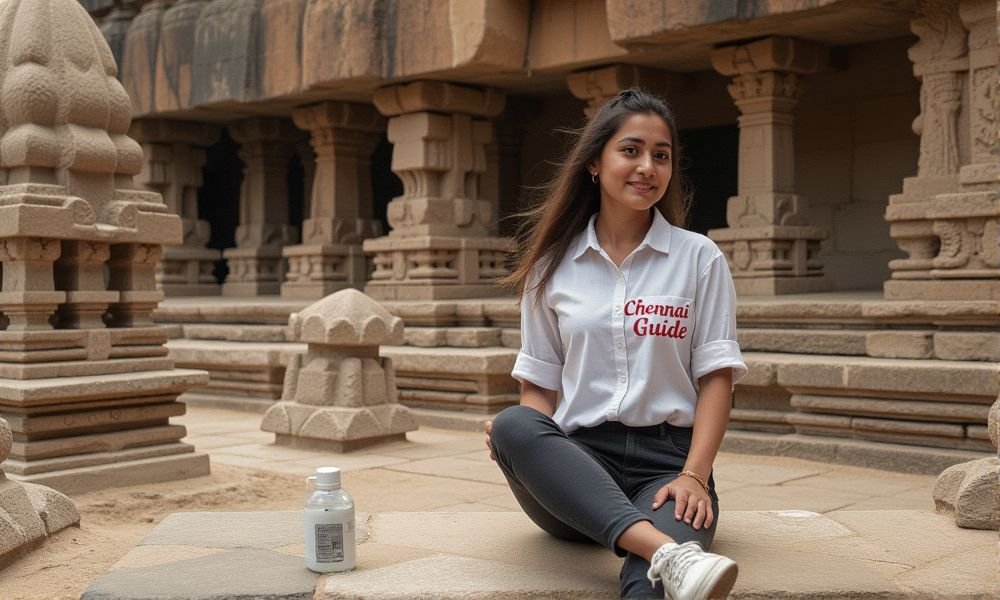Mahabalipuram: The UNESCO World Heritage Gem of South India
Rich Historical Legacy
Mahabalipuram, also known as Mamallapuram, stands as one of India’s most historically significant coastal towns, tracing its origins to over 2,000 years ago when it flourished as a thriving harbor during the early Christian era. The town was mentioned in the 1st century AD Greek work ‘Periplus of the Erythrean Sea’ and by Ptolemy, the 2nd century AD Greek geographer. Originally known as Mallai or Kadalmallai in ancient times, the area became prominent during the Pallava dynasty’s reign between the 6th and 9th centuries CE, serving as their second capital after Kanchipuram.
The Pallavas transformed this bustling seaport into an architectural marvel under the patronage of rulers like Mahendravarman I (600-630 CE) and his son Narasimhavarman I, who built most of the monuments we see today. The town reached its zenith during the reign of Rajasimha (Narasimhavarman II; 690–728 CE), when the magnificent Shore Temple was constructed. Archaeological discoveries including Roman coins and artifacts suggest extensive trade connections across Southeast Asia and beyond. European sailors named it the “Land of Seven Pagodas” due to the seven temple spires visible from the sea, though most remain submerged today. This UNESCO World Heritage Site, designated in 1984, represents the pinnacle of early Dravidian architecture and marks the transition from rock-cut to structural temple building.
Architectural Marvels and What to See
The Group of Monuments at Mahabalipuram comprises an extraordinary collection of 7th and 8th-century religious monuments showcasing five distinct categories of architectural excellence. The Shore Temple complex, consisting of three shrines dedicated to Lord Shiva and Vishnu, stands majestically on the Bay of Bengal’s edge as one of India’s oldest structural stone temples. The famous Pancha Rathas (Five Chariots) are monolithic temples carved from single granite blocks, each representing different architectural styles and dedicated to various Hindu deities.
Arjuna’s Penance, also known as the Descent of the Ganges, is the world’s largest bas-relief sculpture carved on two massive rock faces, depicting the sacred river’s descent to Earth. The mandapas (rock-cut caves) include the Varaha Cave Temple, Mahishasuramardini Cave, and Krishna Mandapam, featuring intricate sculptures and reliefs. Krishna’s Butterball, a 250-ton boulder precariously balanced on a hillside, has become an iconic landmark. The Tiger Cave, located slightly outside the main complex, showcases unique rock-cut architecture. Additional attractions include the Mahabalipuram Lighthouse offering panoramic views, the India Seashell Museum housing marine artifacts, and the Sculpture Museum displaying the region’s stone carving traditions.
Famous Nearby Landmarks and Attractions
Mahabalipuram’s strategic location offers access to numerous fascinating destinations within a short radius. DakshinaChitra, a living museum showcasing South Indian heritage, culture, and traditional crafts, provides insights into regional customs and architecture. The Crocodile Bank, one of India’s largest reptile conservation centers, houses diverse species of crocodiles, alligators, and snakes, making it an educational attraction for families.
Covelong Beach (Kovalam), just 12 kilometers away, offers pristine sands, water sports activities, and the historic Covelong Fort. The Muttukadu Backwater provides opportunities for boating, kayaking, and water sports in a serene lagoon setting. Vedanthangal Bird Sanctuary, approximately 85 kilometers inland, serves as one of India’s oldest water bird sanctuaries attracting over 40,000 migratory birds annually. Kanchipuram, the ancient “City of Thousand Temples,” lies 65 kilometers away and showcases magnificent Dravidian temple architecture and silk weaving traditions. Sadras, a former Dutch colonial outpost, offers historical fort ruins and coastal views. The ECR (East Coast Road) itself becomes an attraction, providing scenic coastal drives with glimpses of fishing villages, backwaters, and beach resorts stretching towards Pondicherry.
Optimal Visiting Seasons and Weather
The best time to visit Mahabalipuram is during the winter months from October to March, when the coastal town experiences its most pleasant weather conditions. During this period, temperatures range between 16°C to 28°C, with warm days and cool, comfortable nights ideal for sightseeing and outdoor activities. The peak tourism season falls between December and February, when the weather is most salubrious and the famous Mahabalipuram Dance Festival takes place. November marks the end of the monsoon season, revealing lush green landscapes while maintaining comfortable temperatures.
The winter months are particularly suitable for beach activities, temple visits, photography, and exploring the outdoor monuments without the hindrance of excessive heat. Summer months from March to May should generally be avoided due to temperatures rising to 35-42°C, though the coastal sea breeze provides some relief. The monsoon season (June to September) brings intermittent heavy showers and high humidity, with temperatures around 25-36°C, though the occasional rains create a scenic ambiance for nature enthusiasts. Visitors should note that the cyclone season typically occurs between October and December, though modern weather forecasting provides adequate warnings.
Premium Accommodation Options
Mahabalipuram offers an impressive range of luxury resorts and hotels catering to diverse preferences and budgets. The Radisson Blu Resort Temple Bay Mamallapuram stands as the premier choice, featuring spacious sea-view rooms, multiple dining options, spa services, and direct beach access. The InterContinental Chennai Mahabalipuram Resort represents the pinnacle of luxury, offering world-class amenities, lavish spa treatments, and exceptional dining experiences.
Kaldan Samudhra Palace provides elegant accommodations with stunning ocean views, well-maintained pools, and traditional hospitality. The Ideal Beach Resort offers family-friendly facilities including private beach access, landscaped gardens, and diverse recreational activities. Welcomhotel by ITC Hotels – Kences Palm Beach combines luxury with eco-friendly practices, featuring modern amenities and cultural programs. For boutique experiences, the Grande Bay Resort and Spa provides intimate luxury with personalized services and holistic wellness programs. Chariot Beach Resort spans 45 acres with extensive facilities for group events and water sports. The Four Points by Sheraton Mahabalipuram Resort & Convention Center offers contemporary luxury with state-of-the-art conference facilities. Budget-conscious travelers can choose from Golden Sun Beach Resort, Coral Beach Resort, and various boutique properties offering comfortable stays with essential amenities.
Entry Fees and Ticketing Information
Mahabalipuram operates a unified ticketing system for its major monument groups, making it convenient and economical for visitors to explore multiple sites. For Indian citizens, the entry fee is ₹40 per person for access to all major monuments including the Shore Temple and Pancha Rathas. Foreign nationals pay ₹600 per person for the same comprehensive access. Children under 15 years enjoy free entry, making it family-friendly.
The single ticket provides access to all UNESCO World Heritage monuments within the main complex and remains valid for the entire day. Photography is generally free with mobile cameras and basic cameras, while video recording requires an additional fee of ₹25. Professional photography and commercial filming require special permits with significantly higher fees and security deposits. The Tiger Cave, located outside the main complex, has a separate entry fee structure. Vehicle parking is available free of cost at all major entry points. Tickets can be purchased online through the Archaeological Survey of India’s portal or at on-site counters. The monuments operate from 6:00 AM to 6:00 PM daily, though visitors are advised to arrive early to avoid crowds and harsh midday sun.
Distance from Chennai and Accessibility
Mahabalipuram is strategically located approximately 56-60 kilometers south of Chennai, making it easily accessible as a day trip or weekend getaway destination. The journey from Chennai typically takes 1.5 to 2 hours by road, depending on traffic conditions and the chosen route. The most popular and scenic route is via the East Coast Road (ECR), which runs along the Bay of Bengal coastline offering beautiful ocean views throughout the journey.
An alternative route via the Old Mahabalipuram Road (OMR), also known as Rajiv Gandhi Salai, connects through Chennai’s IT corridor before joining the ECR. The distance from Chennai International Airport is approximately 55 kilometers, with direct taxi services and app-based cabs readily available. Multiple transportation options cater to different budgets and preferences, from luxury air-conditioned vehicles to budget-friendly public buses. The journey becomes an experience itself, passing through coastal villages, backwater channels, and glimpses of traditional fishing communities along the ECR. Well-maintained roads and clear signage ensure easy navigation, while numerous restaurants and rest stops along the route provide convenient breaks during the journey.
Transportation Options and How to Reach
Reaching Mahabalipuram is convenient through multiple transportation modes catering to various preferences and budgets. By road, visitors can choose from private taxis, self-drive cars, or buses departing from Chennai’s major terminals. The Tamil Nadu State Transport Corporation (TNSTC) operates regular bus services from Chennai Mofussil Bus Terminus (CMBT) and Thiruvanmiyur Bus Depot, with journeys taking approximately 2 to 2.5 hours. Private bus operators provide additional services with flexible timings and enhanced comfort. For train travelers, the nearest railway station is Chengalpattu Junction, located 30 kilometers from Mahabalipuram.
Trains from Chennai Central to Chengalpattu take 1.5 to 2 hours, followed by a 45-minute taxi ride to reach the monuments. Air travelers land at Chennai International Airport, from where pre-paid taxis, app-based cabs, and airport shuttle services provide direct connectivity. Many visitors opt for organized day tours that include transportation, guided visits, and sometimes meals, available through travel agencies in Chennai. For adventure enthusiasts, motorcycle rentals and self-drive car options allow flexible exploration of the coastal route. The well-developed tourism infrastructure ensures comfortable journeys with clean restrooms, fuel stations, and dining options strategically located along major routes.
Cultural Events and Festival Calendar
Mahabalipuram’s cultural calendar is dominated by the spectacular Indian Dance Festival (formerly Mamallapuram Dance Festival), held annually from December to January against the backdrop of ancient monuments. This month-long celebration features renowned classical dancers performing Bharatanatyam, Kuchipudi, Kathak, Odissi, Mohiniyattam, and Kathakali on open-air stages near the Shore Temple and Arjuna’s Penance. Organized by the Tamil Nadu Tourism Department, the festival includes both classical and folk dance forms like Mayilattam, Karagam, Kavadi, Thappattam, and Oyilattam. Performances typically run from 5:30 PM to 8:30 PM, with entry completely free for all visitors.
The Masi Magam Festival, celebrated during the Tamil month of Masi (February-March), brings religious fervor with temple processions and rituals. Pongal, Tamil Nadu’s harvest festival in January, transforms the town with kolam (rangoli) decorations, traditional music, and community celebrations. The architectural monuments themselves become venues for various cultural programs throughout the year, including classical music concerts and heritage walks. Photography competitions, art exhibitions, and sculpture workshops coincide with major festivals, celebrating the town’s artistic heritage. Local fishermen communities organize seasonal festivals celebrating maritime traditions, offering visitors authentic cultural experiences beyond the monuments.
Official Resources and Website Information
For comprehensive and up-to-date information about Mahabalipuram, visitors should consult official tourism portals and government websites. The Tamil Nadu Tourism Department’s official website (tamilnadutourism.tn.gov.in) provides detailed information about monuments, festivals, accommodation options, and travel guidelines. The District Tourism Development Officer operates from Kovalam Road, Mamallapuram (Pin: 603104) and can be contacted at 044-27442232 or 9176995869. The official email addresses include to.mamallapuram@tn.gov.in and kpmtourism@gmail.com for specific queries. The Archaeological Survey of India’s online portal (asi.payumoney.com) facilitates advance ticket booking for monuments. Mahabalipuram.co.in serves as a comprehensive unofficial guide providing practical information about attractions, accommodation, and travel tips.
The UNESCO World Heritage Centre’s website (whc.unesco.org) offers detailed documentation about the monuments’ historical significance and conservation efforts. Social media platforms including Facebook (TouristofficeKanchipuram) and Twitter (@TOURISTOFFICEK) provide real-time updates about events and festivals. For accommodation bookings, visitors can use major travel websites or contact resorts directly through their official websites. Local tour operators and certified guides can be arranged through the tourism office or reputable travel agencies, ensuring authentic and informative experiences while exploring this magnificent World Heritage destination.








